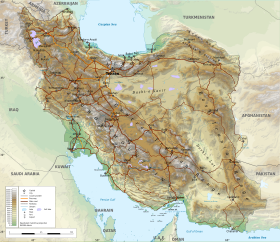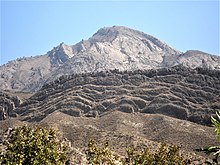Kopet Dag
| Kopet Dag | |
|---|---|
| کپهداغ | |
 View of the Kopet Dag in early spring fromBereket,Turkmenistan | |
| Highest point | |
| Peak | Kuh-e Quchan |
| Elevation | 3,191 m (10,469 ft) |
| Dimensions | |
| Length | 650 km (400 mi) |
| Naming | |
| Native name | Köpetdag;کپهداغ |
| Geography | |
| Countries | Turkmenistan and Iran |
| Range coordinates | 38°4′N57°22.4′E/ 38.067°N 57.3733°E |

TheKöpet Dag,Kopet Dagh,orKoppeh Dagh(Turkmen:Köpetdag;Persian:کپهداغ), also known as the Turkmen-Khorasan Mountain Range,[1]is amountain rangeon the border betweenTurkmenistanandIranthat extends about 650 kilometres (400 mi) along the border southeast of theCaspian Sea,stretching northwest-southeast from near the Caspian Sea in the northwest to theHarirudRiver in the southeast.[2]In the southwest it borders on the parallel eastern endings of theAlborz mountainsbeing together part of the much largerAlpide belt.The highest peak of the range in Turkmenistan is the Mount Rizeh (Kuh-e Rizeh), located at the southwest of the capitalAshgabatand stands at 2,940 metres (9,646 ft). The highest Iranian summit is Mount Quchan (Kuh-e Quchan) at 3,191 metres (10,469 ft).[3]
Etymology
[edit]Vamberyconjectured thatköpetoriginates from the Turkmen language where "köp" means "a lot" or "many" and the word "dag" means "mountain" or "peak". He thus translated Köpetdag as "Many mountains (peaks)". He and others noted that in Persiankoppehmeans "pile" or "heap", and the worddagordaghmeans "mountain" in Turkic. Thus, a second conjecture held that the Persian version ofKopet DaghorKoppeh Daghcould be defined as "the mountain that is piled or heaped" and therefore the words could mean "piled or hilly mountains" or "low hills" in general. Ataniyazov, however, rejects those hypotheses:
The wordkopetis probably derived from the Persian wordkuhibet(kuh- "dag",bet- "bad" ) and means "bad mountain". No name was given to the entirety of this range, but a name was given to each part of it...According to Murzayev, the section of this mountain range west of Ashgabat was called Kopetdag (Murzayev. SA, p. 248). The most common name for this part of the range wasTaňrigargan( "God bless you" )...the Persians called itKupet...(in Persian this name is wah, i.e., it is spelled with a long drawn-out Ku: pet and Ku: bet). For the most part, it was very dangerous to cross, because of the wind and the cold. That is why the Persians call the mountain range "bad mountain" and the Turkmens call it "God bless you". In the second half of the last century, Russian scholars who studied in the Kopetdag passed the name onto maps as the name of the entire range and spread it to the public. Many of the elders living in the foothills of the Kopetdag do not know the name Kopetdag...Vambery conjectures that the wordkopetis derived from the wordskubbet,kuppe(perhaps a lot — S.A.)...Pomerantsev also interprets the name as "multi-mountain" (mountain range), while the locals consider it part of the mythical Cape Mountain in Kopet, but these interpretations are incorrect.[4]
Geology
[edit]

Geologically, the Kopet Dag Range is made chiefly ofLower Cretaceoussedimentary rockswith a smaller portion ofJurassicrocks in the southeastern parts.[5][6]The mountains were formed in theMioceneand thePlioceneduring theAlpine orogeny.As theTethys Seawas closed and theArabian Platecollided with theIranian Plateand was pushed against it and with the clockwise movement of theEurasian Platetowards the Iranian Plate and their final collision, the Iranian Plate was pressed against the Turan Platform. This collision folded the entire rocks that had been deposited in thisgeosynclineor basin from the Jurassic to the Miocene and formed the Kopet Dag Mountains.
Topography
[edit]
The Kopet Dag Range is a region characterized by foothills, dry and sandy slopes, mountain plateaus, and steep ravines. The Kopet Dag is undergoing tectonic transformation, and is subject to severe earthquakes. Earthquakes exceeding seven on the Richter scale have been recorded.[7]

The most western foothills of the Kopetdag mountains are known as the 'Kürendag Ridge'.
Archaeology
[edit]There is archaeological evidence of settlement in the well-watered northern foothills of the Kopet Dag during the Neolithic period. This region is dotted with the multi-period hallmarks characteristic of the ancient Near East, similar to those southwest of the Kopet Dag in theGorgan Plainin Iran. AtJeitun(or Djeitun), mud brick houses were first occupied c. 6000 BC (seeBMAC origins). Also the foothills of the Kopet-Dag near Ashgabat are the site of the remains of the ancientParthiancity ofNisa(Nessa, Nusaý).
Ski resort
[edit]
This mountain range has aski resort,officially opened by the former president of Turkmenistan,Saparmurat Niyazov.Despite the lack of snow in the Kopet Dag mountains, Niyazov was determined to build a major resort there.[8][9][10]
Plants and animals
[edit]
The woodlands of the region are home to many fruit trees, shrubs, and vines that have proved valuable for human use andselective breeding,includingpomegranate(Punica granatum), wild grapesVitis sylvestris,fig(Ficus carica), wild apple (Malus turkmenorum), wild pear (Pyrus boissieriana), wild cherries (Prunus spp.,also calledCerasus microcarpa, C. erythrocarpa, C. blinovskii), wild prune (Prunus divaricata),almonds(Amygdalus communis=Prunus dulcis,andA. scoparia=Prunus scoparia), and hawthorns (Crataegusspp.).
See also
[edit]References
[edit]- ^"خرِبِت كُپِتدَگ: Iran".Retrieved2010-09-09..
- ^Microsoft Encarta World Atlas, 2001, Microsoft Corporation
- ^Kopet-Dag Range, Encyclopædia Britannica, britannica
- ^Atanyyazov, S. (1970).Türkmenistanyň Toponymyk Sözlügi(in Turkmen). Ashgabat: Ylym. pp. 152–153.
- ^Geological Map of Iran,National Geoscience Database of Iran,ngdir.ir
- ^Geological Map of the Middle East, published by Geological Survey of Iran, Second Edition, 1993
- ^Oct. 5, 1948 - More than 110,000 people were killed by 7.3 quake.Staff (11 January 2005) "World's worst natural disasters since 1900"CBS News
- ^Turkmen government announces new construction projectsArchived2014-01-06 at theWayback MachineUniversal Newswires, accessed on November 15, 2012.
- ^We need to talk about TurkmenistanBBC, accessed on February 9, 2017.
- ^Ski Turkmenistan![permanent dead link]Google Earth Community, accessed on February 9, 2017.

